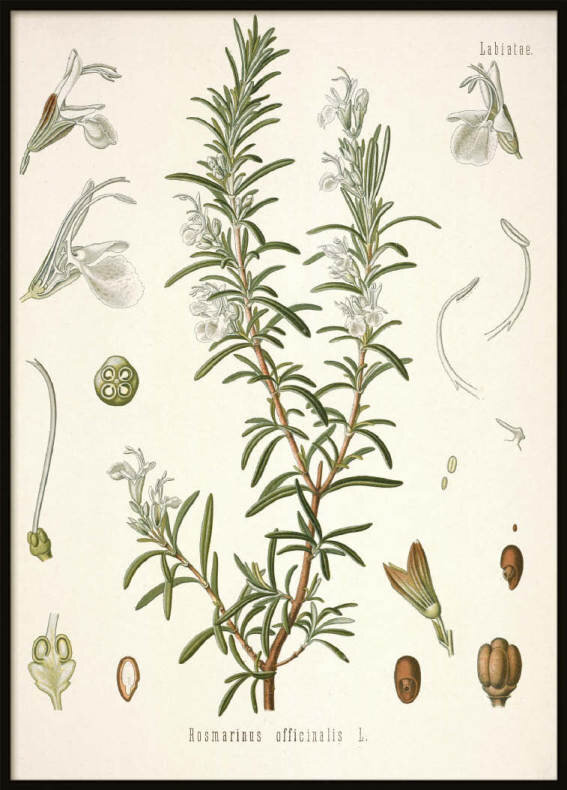Rosemary (Rosemarinus officinale)
by Dana Aronson
“Rosemary is the smell of déjà vu and the after-breath of nostalgia. Her gift is the faint scent that teases and vanishes, leaving you longing for something you can’t quite name, and with memories that crest and crash, pulling you gasping into their undertow” -Maia Toll
Common Names: Rosemary
Latin Name: Rosemarinus officinale
Plant Family: Lamiaceae
Parts Used: Aerial parts, leaving out the woody stems towards the bottom of the plant
Energetics: Bitter and warming
Herbal Actions: Carminative, antispasmodic, antidepressant, rubefacient, antimicrobial, emmenagogue, antioxidant, circulatory stimulant, bitter
Botany:
Rosemary is a shrubby perennial evergreen and is loosely related to mints. This plant that has dark green leaves and small flowers, range from purples to light blues. The needle-like leaves are about an inch long, and are a pale green underneath. Rosemary is high in volatile oils that are aromatic and somewhat camphoraceous. Much of this plants active volatile oils reside in the flowers calyces. Usually growing to about three feet, rosemary can reach upwards of six feet. The plant typically flowers in springtime when in temperate climates, but can be in constant bloom in warmer climates. Rosemary is also known for flowering outside of the “normal” season. Flowering can happen as late as December and as early as February (2).
Collecting and Cultivation:
Native to the Mediterranean region, rosemary has naturalized throughout Europe, Asia and in the Americas. While preferring warmer climates, this plant is quite hardy in cooler climates. Living as long as 30+ years, rosemary can withstand droughts, and sometimes can even be considered invasive. Starting from seed can be difficult because of the slow growth rate and low germination, so this plant is recommended as a start.
Historical Uses:
The Ancients of Rome and Greece used rosemary for “strengthening” the memory, but that wasn’t all. Not only was it used for consumption, rosemary was used at funerals, weddings, festivals, in magical spells, and was also used as an incense in ceremonies, specifically religious ceremonies. Sir Thomas More wrote:
“As for Rosmarine, I lett it runne all over my garden walls, not onlie because my bees love it, but because it is the herb sacred to remembrance, and, therefore, to friendship; whence a sprig of it hath a dumb language that maketh it the chosen emblem of our funeral wakes and in our burial grounds.”
An old French name for rosemary was often called “Incensier.” It was an old practice to burn rosemary in hospitals, and was often paired with Juniper berries to prevent infection and purify the air of the sick chambers. It was also a common custom to place sprigs of rosemary in the hands at funerals, and put onto coffins when lowered into the ground. This tradition is still alive and well in many parts of Wales. The old saying goes, “rosemary is for remembrance.” (2)(6).
Modern Uses:
Known for being a common spice in our kitchen cupboards, rosemary is so much more! Modern day herbalists use rosemary for mental clarity, cloudy thinking, brain fog, and what David Winston calls “stagnant depression” (6). It can have an affinity to places where there is stagnancy in the mind, emotions, and areas of the body. Rosemary supports the cardiovascular system even down to the small capillaries in the brain, extremities and eyes. This can be beneficial when folks struggle with vasoconstrictive headaches and tense muscles. Along with rosemary’s affinity to the brain and memory, it is also an antioxidant that helps decrease oxidative stress and free radicals in the body. This can be useful in cases of diabetes, cancer, and arthritis. Rosemary’s volatile oils, makes this herb a great carminative and bitter, which can help ease pains from gas or bloating, especially when psychological tension is happening. The bitter taste that is present in rosemary can help stimulate the liver, gallbladder, bile production and digestive juices. This is one of the reasons why it is so commonly paired with fatty meals as a spice. Externally, this plant can be used to help dilate the capillaries to stimulate blood flow to an area that has been hit with trauma like a twisted ankle, or pain caused by tension. And for those people who want an herb for hair, this plant stimulates hair follicles and circulation in the scalp. Use the essential oil in a leave-in hair oil, or in your shampoo. The essential oil can also be used to rub on the temples or at the base of the head to relieve headaches, drowsiness and increase concentration. The fresh leaves can be chewed for a breath refresher, or to combat infection in the gums (3)(4)(6).
Personal and Clinical Experience:
Through my journey with plants, rosemary was the first plant that I had a visionary experience with. Rosemary guided me into a grey night with a grandmother energy holding the scene. I find this theme strong with the energetic medicine of rosemary. I tend to use this plant in drop doses when the spirit has been cut off from tradition and lineage, the forgotten stories of our past. When someone’s family or ancestral stories have been cut off, rosemary can stimulate blood to run through the body, pulling on the DNA to remember. Just like how this plant keeps its leaves all year round, our lineage is with us 24/7. Clinically, I have used this herb when people have a cold constitution, a weakened circulatory system, and struggle with brain fog. This gentle stimulating nervine has been beneficial in practice when folks express hard times coming off of caffeine, especially that first cup in the morning. One of my favorite combinations for this is rosemary paired with rhodiola. Lastly, in my practice there have been a few folks that have had success with a rosemary tea for decreasing discomfort from tension in the neck and base of the head.
Combinations:
Brain Health: Gotu Kola, Rhodiola, Peppermint, Rosemary
Circulatory Heath: Hawthorn, Motherwort, Linden, Rosemary
Nervous System Health: Avena, Tulsi, Nettle, Rosemary
Flower Essence:
“For those who tend to be forgetful, absent minded, dreamy, and not grounded in their physical body. They may feel insecure, and lacking warmth and vital energy. It increases warmth, vitality and confidence physically and emotionally, and awakens the mind” (4).
Dosage and Preparation:
-Tincture: 1-2 ml / 3x a day (1:5 in 40% alcohol) (3).
- Infusion: 1 oz of dried herb per quart. Put herbs in a jar, pour post boiling water over, cover and let steep for 30 minutes (1). A recommended dose is 3 cups of tea per day.
-Glycerite: Use 55% glycerine and 45% water. Add herbs to the glycerine/water mix at a 1:5 ratio. Simmer herbs in mixture, covered, for 30 minutes. Then strain and bottle (1).
Contraindications:
Avoid using large doses during pregnancy or when trying to conceive, and in cases of vasodilative headaches.
Want more herbal goodness?
🌼Sign up for the HerbRally newsletter and receive these THIRTEEN herbal freebies!
VIDEO | Most Vital Herb in David Hoffmann’s First-Aid Kit
WEBINAR | Herbal First Aid with Heather Irvine
EBOOK | 86 Page Plant Healer Book
30 DAYS FREE | HerbRally Schoolhouse
EBOOK | Calendula for Radiant Skin by Rosalee de la Forêt
VIDEO | 5 Herbal Events Around the World presented by Bevin Clare
BOOK DISCOUNT | The Essential Guide to Western Botanical Medicine
PRIVATE COMMUNITY | HerbRally Facebook Group
BOOK EXCERPT | 36 Pages from Plant Healer's "Nourishing Foods" Book
DISCOUNT | 15% off all Mountain Rose Herbs products
DISCOUNT | Mushroom Revival
AUDIO | Hour-long Adaptogens Class with Heather Irvine
DISCOUNT | 10% off all HerbRally products
👉 CLAIM YOUR FREEBIES!
Trained as a clinical herbalist, Dana Aronson takes joy in community based, hands on learning. She focuses her studies on bio-regional plants from the Pacific Northwest and intertwines them into her small practice based in Southern Oregon. After finishing a 3-year clinical herbalism program at Ohlone Herbal Center in Berkeley, California, she found her curiosity leading her to traveling herbal pop up clinics. These pop up clinics provide herbal first aid and wellness to a wide range of areas from gatherings to places that have been hit with natural devastation. She teaches in the classroom, through community herb walks, and cultivates her product line, Wild Kin Botanicals. She would like to thank some of her mentors for guidance along the way - Pam Fischer, Dixie Pauline, Greta de la Montagne, Will Morris, Lisa SF, Tanya Stiller, and Francisca Santibanez. For more information on Dana, visit: www.wildkinbotanicals.com
RESOURCES:
(1) Easley, Thomas, and Steven H. Horne. The Modern Herbal Dispensatory: a Medicine-Making Guide. North Atlantic Books, 2016.
(2) Grieve, M. A Modern Herbal: Complete Volume. Stone Basin Books, 1992.
(3) Hoffmann, David. Medical Herbalism: the Science and Practice of Herbal Medicine. Healing Arts Press, 2003.
(4) McIntyre, Anne. Flower Power: Flower Remedies for Healing Body and Soul Through Herbalism, Homeopathy, Aromatherapy, and Flower Essences. New York: Henry Holt and Co, 1996.
(5) Moore, Michael. Medicinal Plants of the Mountain West. Museum of New Mexico Press, 2003.
(6) Winston, David, and Steven Maimes. Adaptogens: Herbs for Strength, Stamina, and Stress Relief. Healing Arts Press, 2019.





